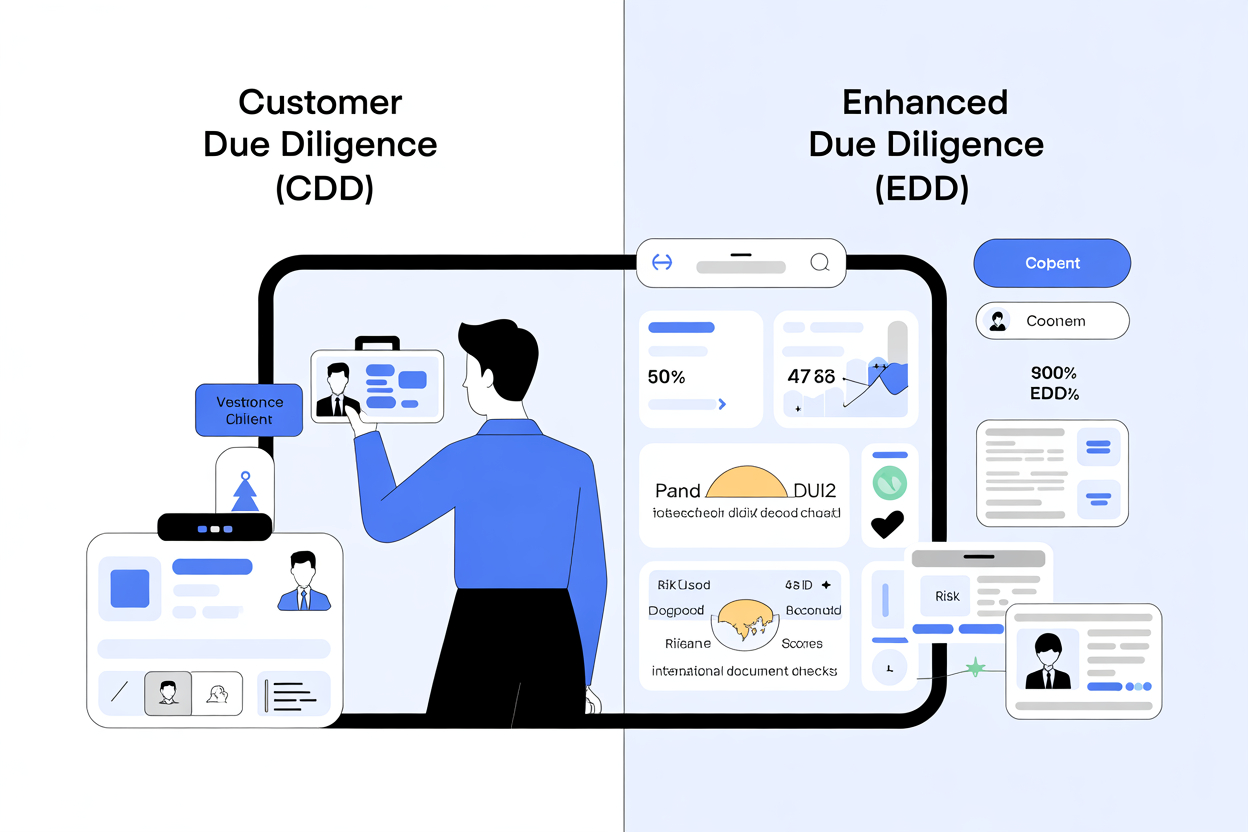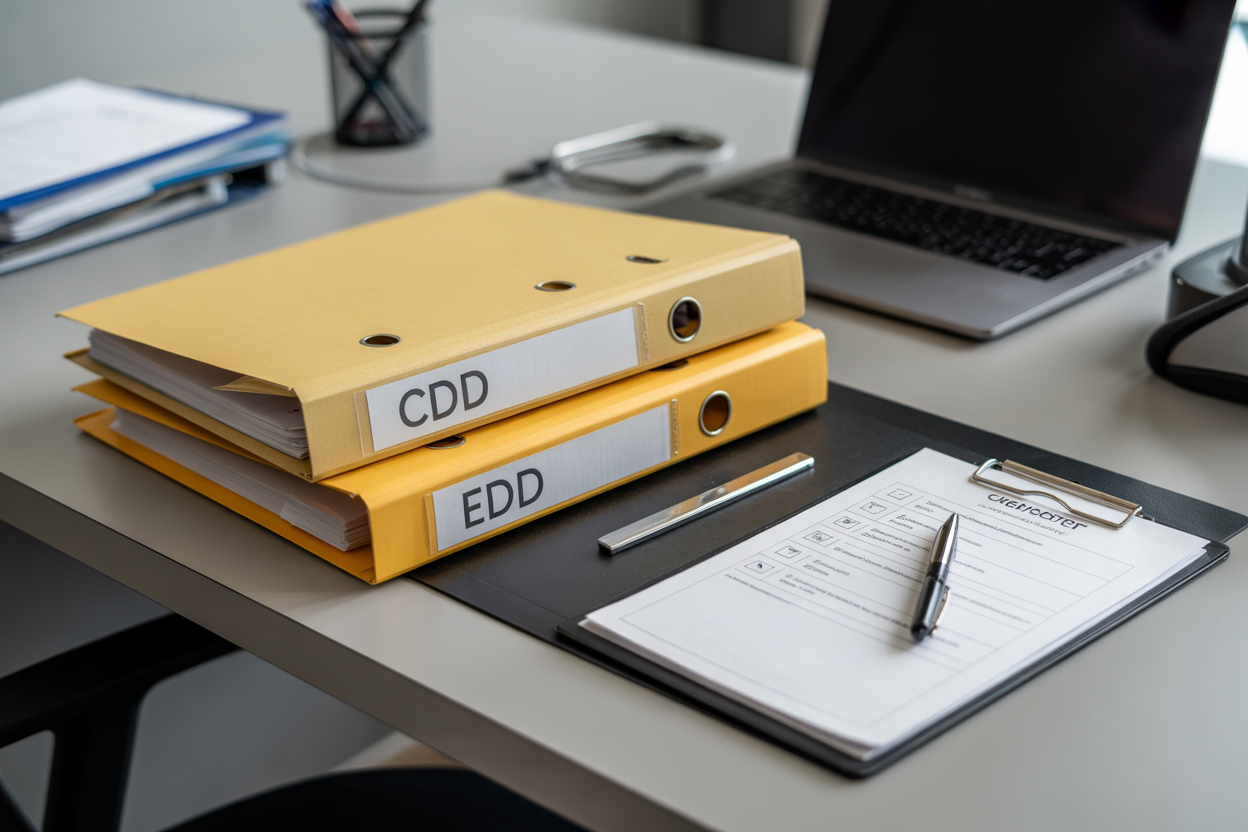
In today’s compliance climate, Customer Due Diligence (CDD) and Enhanced Due Diligence (EDD) form the foundation of every anti-money-laundering (AML) program. Yet the two terms are often confused or used interchangeably, even though the distinction determines how regulators judge a firm’s entire risk-management framework.
As AML expectations expand in 2025, compliance officers must know precisely when standard CDD is enough and when a customer requires escalation to EDD. The difference defines regulatory exposure, resource allocation, and institutional reputation.
Firms worldwide rely on BusinessScreen.com to operationalize these layers of due diligence. Its investigator-verified solutions bridge the gap between automated onboarding and deep forensic review, ensuring each client relationship is fully defensible to regulators.
Customer Due Diligence is the baseline process every financial institution performs to verify a customer’s identity, business activity, and legitimacy. It establishes the risk profile at onboarding and lays the groundwork for ongoing monitoring.
A CDD file typically includes identification documents, business registration certificates, beneficial-ownership declarations, and sanctions screening results. The goal is simple—confirm that the customer is who they claim to be and that their activities align with declared business purpose and risk category.
For practical examples, reference What Is Customer Due Diligence (CDD)? and the Corporate KYC Guide from BusinessScreen.com, which outline the minimum documentation regulators expect under FATF Recommendation 10.
When executed properly, CDD prevents shell companies, sanctioned individuals, and high-risk clients from entering the financial system unnoticed. But CDD alone isn’t designed to uncover complex money-laundering networks—that’s where EDD begins.

Enhanced Due Diligence applies to clients whose profiles exceed normal risk thresholds—such as politically exposed persons (PEPs), offshore structures, high-risk industries, or customers flagged by adverse media.
EDD investigates the source of funds, source of wealth, and beneficial ownership in greater detail. It goes beyond verifying identity to understand how money is earned and moved. This process is mandated under both FATF and FinCEN’s Corporate Transparency Act (CTA) guidelines.
Institutions performing EDD must produce an audit-ready report—complete with ownership charts, investigative notes, and supporting documentation. You can review this structure in BusinessScreen.com’s Due Diligence Sample Report.
EDD reduces enforcement exposure and strengthens regulatory and investor confidence. When handled by BusinessScreen.com, it combines AI-driven screening, adverse-media analytics, and human investigation to identify hidden control and reputational risks before onboarding.
While both CDD and EDD share core compliance components such as identity verification, sanctions screening, and transaction review, they differ sharply in depth, frequency, and documentation standards.
Key Differences Between CDD and EDD:
CDD answers who the customer is, while EDD uncovers how and why they operate — ensuring every client relationship can withstand regulatory inspection.
Knowing when to move from standard CDD to enhanced EDD is central to a risk-based AML program. Escalation occurs when a client triggers red flags or indicators that can’t be resolved through ordinary verification.
For example, a client identified as a PEP or operating in a high-risk jurisdiction may require enhanced due diligence immediately. Businesses with complex ownership structures or links to adverse media—such as corruption or litigation—also warrant deeper scrutiny. Similarly, when source-of-funds documentation is inconsistent or unverifiable, escalation is mandatory.
Each trigger should initiate a formal EDD workflow that includes additional document collection, open-source research, and manual review by qualified compliance staff. For illustrations, see Reputational Due Diligence Indicators.
A typical example might involve a client who passes CDD but later appears in adverse media reports. Under a risk-based framework, that relationship must escalate to EDD to validate beneficial ownership and verify source of wealth.
The most effective compliance programs don’t treat CDD and EDD as separate boxes to tick—they form a continuous cycle of risk management. Modern AML platforms like BusinessScreen.com use automated risk tiering to assign each client to a corresponding level of scrutiny.
When a low-risk client’s profile changes (for instance, new beneficial owners or suspicious activity), the system prompts re-screening and potential EDD escalation. Conversely, consistent clean results may justify returning to standard CDD.
Integration also simplifies reporting: both CDD and EDD outputs feed a single audit trail that satisfies FinCEN, FATF, and regional AML requirements. For a unified approach, review Predictive Due Diligence 2025 and Third-Party Risk Management 2025.
Learn how BusinessScreen.com streamlines CDD and EDD integration with investigator verification and AI-powered automation.
Both CDD and EDD depend on comprehensive, auditable documentation. Firms must retain records for at least five years post-termination and include all supporting evidence—customer identification data, ownership information, screening results, risk ratings, and rationale for escalation.
Each record should be timestamped, sourced, and stored in a retrievable format to satisfy audit inquiries. BusinessScreen.com automates this process with structured reports meeting the FATF Record-Keeping Guidance and KPMG’s AML Best Practices.

Artificial intelligence and data aggregation are redefining due diligence. Machine-learning models can instantly analyze millions of records for sanctions hits, litigation, or negative news—but human oversight remains vital.
BusinessScreen.com’s AI-Driven Risk Scoring Models rank client risk based on transactional behavior, ownership complexity, and jurisdictional exposure. Its investigator network validates each finding to ensure accuracy and context.
Beyond financial services, corporate buyers and supply-chain teams use Vendor Due Diligence for Supply Chains to screen for sanctions, fraud, and ESG violations.
Global regulators continue tightening CDD and EDD rules:
To manage these standards, reference the OECD Beneficial Ownership Toolkit and Global Business Verification Guide.
Even established AML programs face recurring issues when managing CDD and EDD. Over-reliance on databases often leads to missed local records or aliases. Static risk models fail to account for jurisdictional changes. Unstructured record-keeping makes audit responses painful, and insufficient staff training can blur the CDD/EDD distinction.
To avoid these traps, institutions should combine automated monitoring with investigator oversight and structured reporting templates. Review How to Automate Business Background Checks to see how automation and human analysis can coexist efficiently.
By 2025, leading institutions are shifting from reactive compliance to predictive risk intelligence. Instead of waiting for alerts, they use AI and macroeconomic data to model potential exposures before they materialize.
Predictive systems analyze ownership changes, fund movements, and news sentiment to anticipate risk earlier. Integrating these capabilities into CDD and EDD reduces false positives and sharpens resource allocation.
BusinessScreen.com has pioneered this model through AI-Powered Background Checks and continuous monitoring dashboards—helping firms move from static KYC to dynamic risk visibility.
What is the main difference between CDD and EDD?
CDD verifies customer identity and basic risk; EDD investigates source of funds, ownership complexity, and adverse media to mitigate high-risk exposure.
When should a customer move from CDD to EDD?
Whenever standard KYC cannot resolve red flags such as PEP status, offshore ownership, or negative media.
Do small business clients require EDD?
Only if they operate in high-risk sectors such as cryptocurrency, real estate, or gaming—or if they use layered corporate structures.
How often must EDD be reviewed?
At least annually for high-risk clients and whenever ownership or risk factors change.
Can technology replace human EDD analysis?
No. Automation enhances efficiency, but investigator review remains critical for accuracy and context. Hybrid solutions like BusinessScreen.com’s deliver the best results.